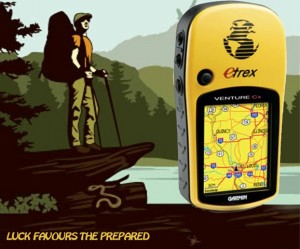Handheld GPS devices are used extensively in the world of land surveying. 10 years ago you would find a civil engineer or land survey in kenya using papers and a compass to survey land, today the most sophisticated are using a handheld GPS receiver.
Understanding two types of GPS
Handheld GPS devices represent a special category of all available GPS (Global Positioning System) receiver units used in various situations and for different applications. The major applicability or usefulness of handheld, portable GPS devices can be divided into two distinctive categories, i.e. for outdoor leisure and sport activities like hiking, trekking, climbing, camping and running and, secondly, for industrial applications like land surveying and position measurements at construction sites. Utilizing the GPS navigation satellite system, correct location of the GPS receiver can be determined by retrieving exact longitude, latitude and altitude coordinates. Today, most GPS receiver units, whether handheld or not, communicate through radio signals with at least four GPS satellites, whereby three satellites determine the exact location of the receiver and the fourth satellite is used for correcting the receiverâEUR(TM)s clock. After the Selective Availability regulation, which provided certain accuracy reservation for military use, was ended in 2000, the precision of civilian GPS improved from about 100m to about 20m.
Handheld GPS devices provide tremendous flexibility and convenience for the user. Not only can the user continuously monitor his, or her, exact and current geographical location and path of travel, but handheld GPS devices can be fitted for relaying with central offices or base stations that can track or follow the user for security and safety reasons. For example, GPS devices that can communicate with and supply coordinates to a central station are very popular by mountain climbers and hikers. As the GPS system has developed and improved over the past years, many new applications have emerged for the users of handheld GPS devices. Not only can users determine their current location, but also obtain a multitude of additional and supportive information through geographical maps, inserted in the GPS receiver units, such as precise navigation, locations of restaurants and hotels, weather reports, tourist attractions, etc. Currently, there are a number of companies producing and offering many different handheld GPS devices. Some of the best known include, Garmin, Magellan and DeLorme. The devices have a broad range of features, attributes and, of course, price tags. Before selecting a particular handheld device, it is important to know what you will be using it for. For example, a GPS device used for hiking may be less applicable for mountain climbing or, even less, running. Obviously, devices for industrial applications have particular requirements and qualities. If you are looking for a handheld GPS device that can be used in different circumstances, a multipurpose unit could be the answer. Furthermore, you need to have an idea of what features you are interested in or require in addition to the standard GPS and mapping functionality, e.g.:
- Touch screen window
- Color screen or black and white
- Built-in camera (like in mobile phones)
- SD (memory) card expandability
- Voice recorder
- Built-in electronic compass
- Barometer
- MP3 Music Player
- External antenna connector
- Etc. etc.
Obviously, as the feature list increases, so does the price. Another important thing to keep in mind is considering what geographical maps may be included or applicable to your needs, e.g. outdoor and recreational maps, street maps or marine maps. Most handheld GPS devices come with some pre-loaded or built-in geographical maps, for example a base map of the USA and Canada containing major highways, city centers, bodies of water and more. You need to find out whether you need additional detailed maps that can be added to the handheld device, for example detailed cartographic maps, topographic maps, and more.
Still another important issue to keep in mind is the GPS software that is normally included with the purchase of a new handheld GPS for uploading GPS data to a computer. By that you can conveniently view all your maps, waypoints, trails and routes from your computer screen. Many other interesting advanced features and possibilities can be implemented with an appropriate handheld GPS receiver including, playing “hide-and-seek” and “treasure-hunting” through geocaching or importing your tracks, waypoints and routes into Google Earth for tracking and monitoring. In short, handheld GPS devices offer a plethora of wonderful possibilities and options.







 eTrex 10
eTrex 10